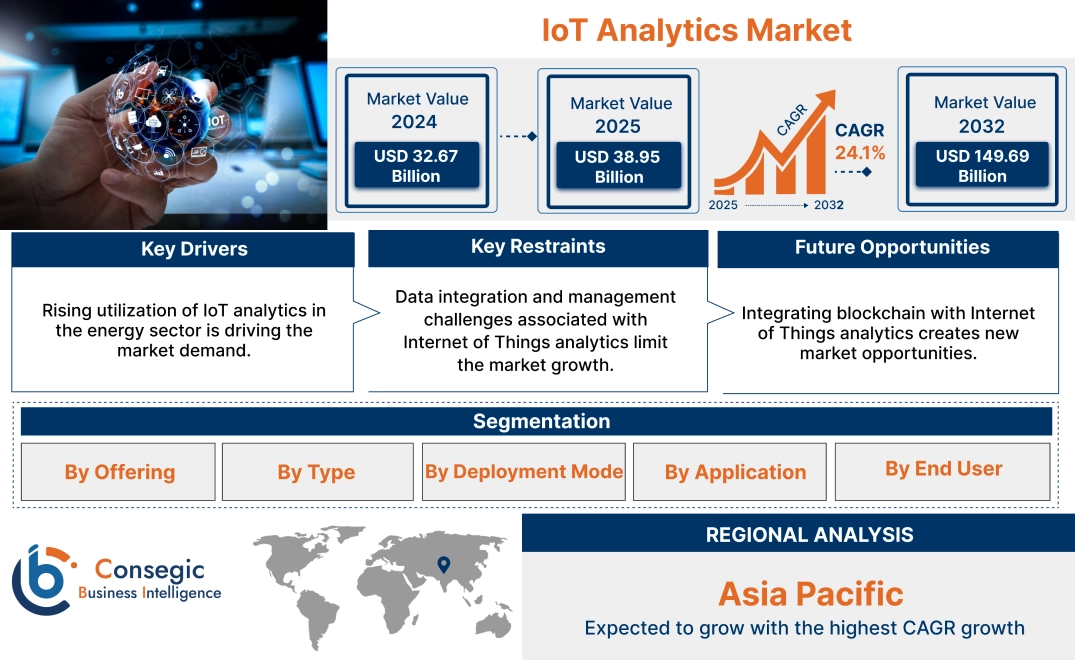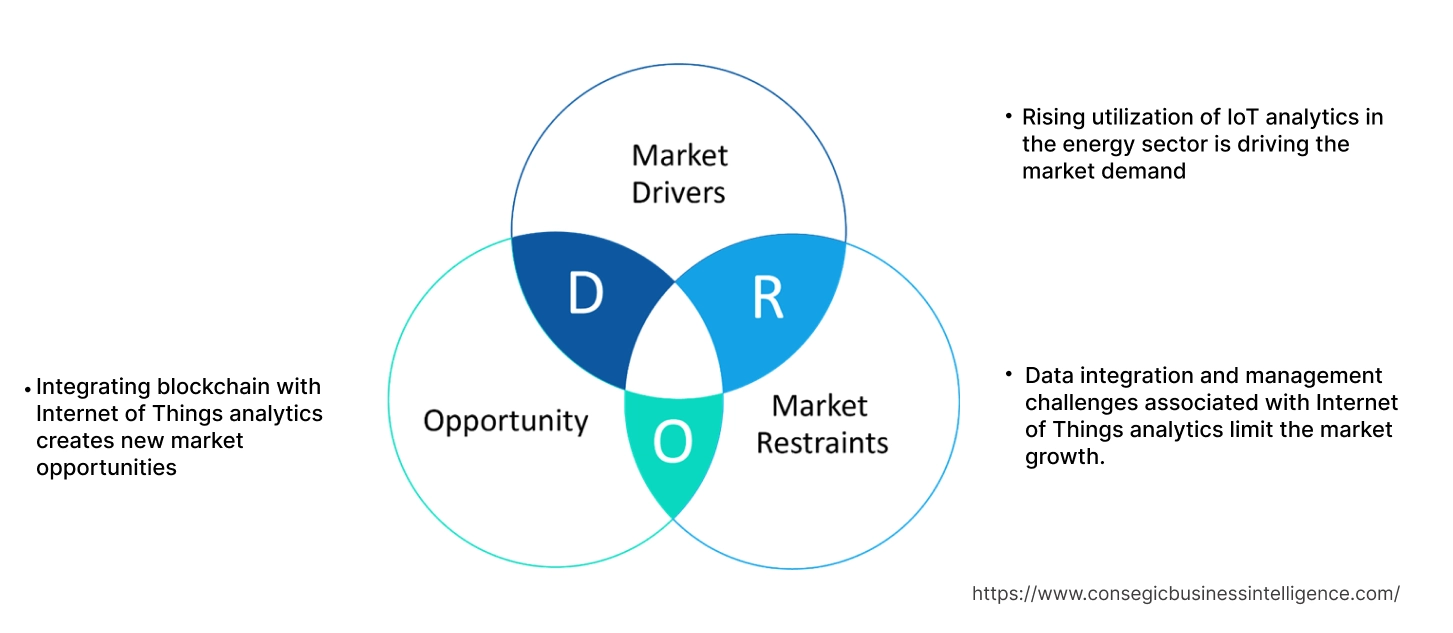IoT Analytics Market Scope & Overview:
IoT analytics, also known as Internet of Things analytics, is the process of collecting, processing, and analyzing data generated by IoT devices. It converts data into useful insights. It assists in data-driven decision-making, reduction of operational costs, and customer insights, along with the identification and elimination of ineffective business processes and flows.
Moreover, it reduces the utility costs with automated resource monitoring, management, and analysis. It is used for livestock monitoring, flood prediction and preparedness, predictive maintenance, taxi fleet matching, detecting faulty windmills, queue management systems, smart water management, intelligent traffic management, remote health monitoring, medical research, and building management applications, among others.
IoT Analytics Market Size:
IoT Analytics Market size is estimated to reach over USD 149.69 Billion by 2032 from a value of USD 32.67 Billion in 2024 and is projected to grow by USD 38.95 Billion in 2025, growing at a CAGR of 24.1% from 2025 to 2032.
IoT Analytics Market Dynamics - (DRO) :
Key Drivers:
Rising utilization of IoT analytics in the energy sector is driving the market demand
Internet of Things analytics in the energy sector uses data analytics technique on data gathered from interconnected sensors and devices. This allows real-time monitoring, optimization of energy consumption, predictive maintenance, and improved grid management. This leads to increased efficiency and cost savings in energy generation, transmission, and distribution systems.
- For instance, according to Optima, independent research revealed that industries including the energy sector in the U.S. have cut down energy usage by 14-22% by using IoT technologies.
Therefore, the rising adoption of Internet of Things analytics in the energy sector is driving IoT analytics market growth.
Key Restraints:
Data integration and management challenges associated with Internet of Things analytics limit the market growth.
IoT devices generate massive amounts of data from various sources, including sensors, actuators, and other systems. This leads to difficulties in storing and processing such large and diverse datasets effectively.
Moreover, there are further challenges related to Internet of Things analytics including inconsistent data quality due to network issues or improper device configuration. Additionally, integrating data from different manufacturers' devices with several protocols and standards can be a complex and challenging task. Thus, the aforementioned factors are hindering the IoT analytics market demand.
Future Opportunities :
Integrating blockchain with Internet of Things analytics creates new market opportunities
Blockchain enables IoT devices to send data to private networks across the internet. This enables businesses to share and access data more securely as each transaction is verified to prevent tampering. Moreover, blockchain technology ensures enhanced data security and transparency among the devices. Furthermore, smart contracts are used to control the communication access between IoT nodes.
- For instance, Teksun offers Blockchain IoT applications services in its solution offerings. It offers several features including data security, data transactions in IoT, and product tracking among others.
Thus, the applications and benefits of integrating blockchain with IoT are anticipated to create new IoT analytics market opportunities during the forecast period.
Top Key Players and Market Share Insights:
The IoT analytics industry is highly competitive with major players providing solutions to the national and international markets. Key players are adopting several strategies in research and development (R&D), product innovation, and end-user launches to hold a strong position in the global IoT analytics market. Key players in the IoT analytics industry include -
- SAS Institue Inc. (US)
- ScienceSoft USA Corporation. (US)
- ThingSpeak (US)
- Ina Solutions (US)
- PTC (US)
- Yalantis (Poland)
- Webbylabs (UK)
- Matellio (UK)
- Qrvey Inc. (US)
- Amazon Web Services (US)
- Tredence (California)
- HData Systems (India)
- SumatoSoft (US)
- Tibbo Systems (Taiwan)
- Factana Computing Inc. (India)
- Datadog (US)
- Software GmbH (Germany)
IoT Analytics Market Segmental Analysis :
By Offering:
Based on the offering, the market is segmented into solutions and services.
Trends in the Offering:
- Rising adoption of Internet of Things analytics solutions in retail for real-time inventory management, customer behavior analytics, and personalized marketing.
- Rising drift in the integration of IoT with edge computing for providing faster real-time insights.
The solutions segment accounted for the largest revenue in the IoT analytics market share in 2024.
- Internet of Things analytics solutions refer to the whole IoT system including device connectivity, data collection, storage, processing, analysis, and management.
- They encompass the entire system including hardware and software to transmit, store, analyze, and manage data. They are a full-package solution for a specific problem.
- These solutions include predictive maintenance in manufacturing using sensor data, real-time fleet management in transportation & logistics, asset tracking in supply chain management, energy consumption scrutiny in homes, and smart building monitoring, among others.
- For instance, Matellio Inc. offers Internet of Things analytics solutions. These solutions provide automated workflows and security.
- Thus, the benefits and wide applications of Internet of Things analytics solutions are driving the IoT analytics market growth.
The services segment is expected to register the fastest CAGR during the forecast period.
- Internet of Things analytics services focus on collecting, processing, and interpreting data from connected devices.
- These services are cloud-based platforms primarily focusing on the data analysis aspect, extracting useful insights from raw data.
- These services include data processing and analysis, visualization and reporting, real-time analysis and management, managing data lifecycle, security, and privacy among others.
- For instance, ScienceSoft USA Corporation offers Internet of Things analytics as a service. This consists of a 4-stage process on a subscription basis.
- Therefore, the benefits offered by IoT services are driving the IoT analytics market trends.
By Type:
Based on the type, the market is segmented into descriptive analytics, diagnostics analytics, predictive analytics, and prescriptive analytics.
Trends in the Type:
- Rising adoption of diagnostics analytics to uncover reasons behind system failures is driving the market growth.
- Rising utilization of predictive analytics to anticipate sales trends is boosting the market.
Descriptive analytics accounted for the largest revenue in the overall market in 2024.
- Descriptive analytics uses historical data to provide useful stats and insights. In this method, the data is compared to create reports, highlighting trends, patterns, and anomalies.
- It uses data visualization methods to present data and key trends through reports and dashboards.
- It helps businesses identify the key areas where they can improve performances by optimizing the operations.
- Thus, the benefits offered by descriptive analytics are boosting the IoT analytics market demand.
Prescriptive analytics is expected to register the fastest CAGR during the forecast period.
- In prescriptive analytics, the data collected from connected devices is used to predict future outcomes as well as recommend actions to optimize operations.
- This is achieved using advanced algorithms, optimization techniques, and stimulations.
- For instance, Tredence offers industrial IoT solutions using prescriptive analytics. These solutions help manufacturers to reduce costs and greenhouse gas emissions.
- Thus, the benefits offered by prescriptive analytics are projected to drive the IoT analytics market opportunities during the forecast period.
By Deployment Mode:
Based on the deployment mode, the market is segmented into cloud, on-premise, and hybrid.
Trends in the Deployment Mode:
- Rising adoption of cloud-based Internet of Things analytics in smart cities to optimize city services.
- Rising integration of hybrid deployment model in the healthcare sector to reduce latency and gain faster real-time insights.
The cloud segment accounted for the largest revenue share of 54.11% in the market in 2024.
- Cloud deployment of solutions offers scalability and flexibility. Businesses easily integrate huge amounts of data from different IoT devices.
- They offer dynamic scaling of resources, ease of maintenance, and integration with other services as per the requirement.
- For instance, Google Cloud offers cloud deployment solutions for businesses. This provides HTTPS and MQTT data connectivity options.
- Thus, the aforementioned factors are driving the IoT analytics market trends.
The on-premise segment is expected to register a substantial CAGR during the forecast period.
- The on-premise solutions store and process the data on local servers. This gives the business full control over the data. This offers accessibility, control, and security.
- Moreover, these solutions allow tailored and customizable configurations to match specific business requirements.
- For instance, Optimized Technologies Inc. offers services for on-premise deployment of IoT infrastructure. It also offers the ability to alter hardware infrastructure and software.
- Thus, the rising advancements related to on-premise deployment of IoT infrastructure are boosting market growth.
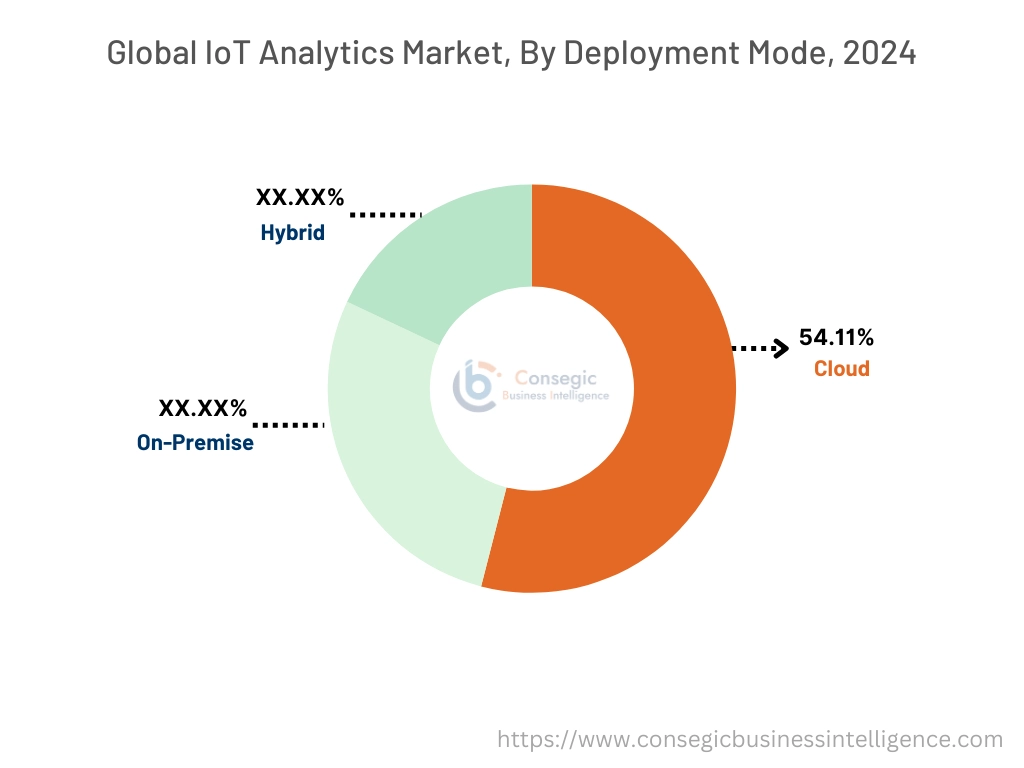
By Application:
Based on the application, the market is segmented into asset management, energy management, inventory management, predictive maintenance, remote monitoring, and others.
Trends in the Application:
- Rising adoption of Internet of Things analytics to monitor energy usage patterns and optimize energy consumption is driving the market demand.
- Rising drift in adopting remote monitoring to get real-time insights is boosting the market growth.
Asset management segment accounted for the largest revenue share in the IoT analytics market share in 2024.
- There is extensive use of Internet of Things analytics to track, monitor, and optimize the performance of physical assets in various industries including manufacturing, utilities, and transportation.
- This fuels the increased demand for solutions that enhance asset utilization and lifecycle management.
- For instance, AWS offers asset management solutions. These solutions enable businesses to monitor, manage, and track assets, produce insights, and improve operational efficiency.
- Thus, IoT analytics market analysis depicts that the above-mentioned benefits of asset management solutions are thereby driving the market.
Predictive maintenance segment is expected to register the fastest CAGR during the forecast period.
- The predictive maintenance solutions and services are adopted across industries for real-time monitoring of equipment and assets.
- Predictive maintenance provides analysis of data to predict equipment failures, carry out proactive interventions, minimize downtime, increase operational efficiency, and reduce maintenance costs.
- For instance, Embitel offers a variety of solutions for predictive maintenance and analytics. These solutions can be tailored to business needs and requirements.
- Thus, the aforementioned factors are driving the IoT analytics market size.
By End User:
Based on the end user, the market is segmented into IT & telecommunication, retail, agriculture, energy & power, healthcare, manufacturing, transportation & logistics, and others.
Trends in the End User:
- Rising adoption of Internet of Things analytics in the IT & telecommunication sector due to its ability to predict failures and reduce downtime.
- Rising drift in the adoption of real-time fleet tracking and route optimization is boosting market growth.
Manufacturing segment accounted for the largest revenue in the market in 2024.
- Internet of Things analytics is primarily used in the manufacturing sector for collecting data from sensors, machinery, or factory equipment.
- This data is used to analyze the production processes in real-time. This allows manufacturers to optimize operations, improve product quality, reduce costs, and predict potential issues by analyzing the insights from the data.
- For instance, in October 2022, Grid Dynamics Holdings Inc. launched its Industrial IoT Analytics Starter Kit for Google Vertex AI. It is able to analyze data collected from systems, evaluate the probability of a system being in an anomalous state, and trigger automatic alerts or actions.
- Therefore, the aforementioned factors are boosting the usage of Internet of Things analytics in the manufacturing sector, in turn, driving the IoT analytics market size.
Healthcare segment is expected to register the fastest CAGR during the forecast period.
- In the healthcare sector, Internet of Things analytics is used to collect and process data from interconnected medical devices.
- This enables real-time insights to make informed decisions. It helps to deliver personalized and customizable treatment plans with remote monitoring systems. Moreover, leveraging analytics reduces medical errors and lowers costs for healthcare organizations.
- For instance, ScienceSoft USA Corporation built an IoT-based physiotherapy platform for Aklos Health. This platform reduced the pain and unnecessary surgeries by 70%.
- Thus, IoT analytics market analysis shows that the wide applications of Internet of Things analytics in the healthcare sector are boosting the market.
IoT Analytics Market Report Insights :
| Report Attributes | Report Details |
| Study Timeline | 2019-2032 |
| Market Size in 2032 | USD 149.69 Billion |
| CAGR (2025-2032) | 24.1% |
| By Offering |
|
| By Type |
|
| By Deployment Mode |
|
| By Application |
|
| By End-User |
|
| By Region |
|
| Key Players |
|
| North America | U.S. Canada Mexico |
| Europe | U.K. Germany France Spain Italy Russia Benelux Rest of Europe |
| APAC | China South Korea Japan India Australia ASEAN Rest of Asia-Pacific |
| Middle East and Africa | GCC Turkey South Africa Rest of MEA |
| LATAM | Brazil Argentina Chile Rest of LATAM |
| Report Coverage |
|
Regional Analysis:
The regions covered are North America, Europe, Asia Pacific, the Middle East and Africa, and Latin America.
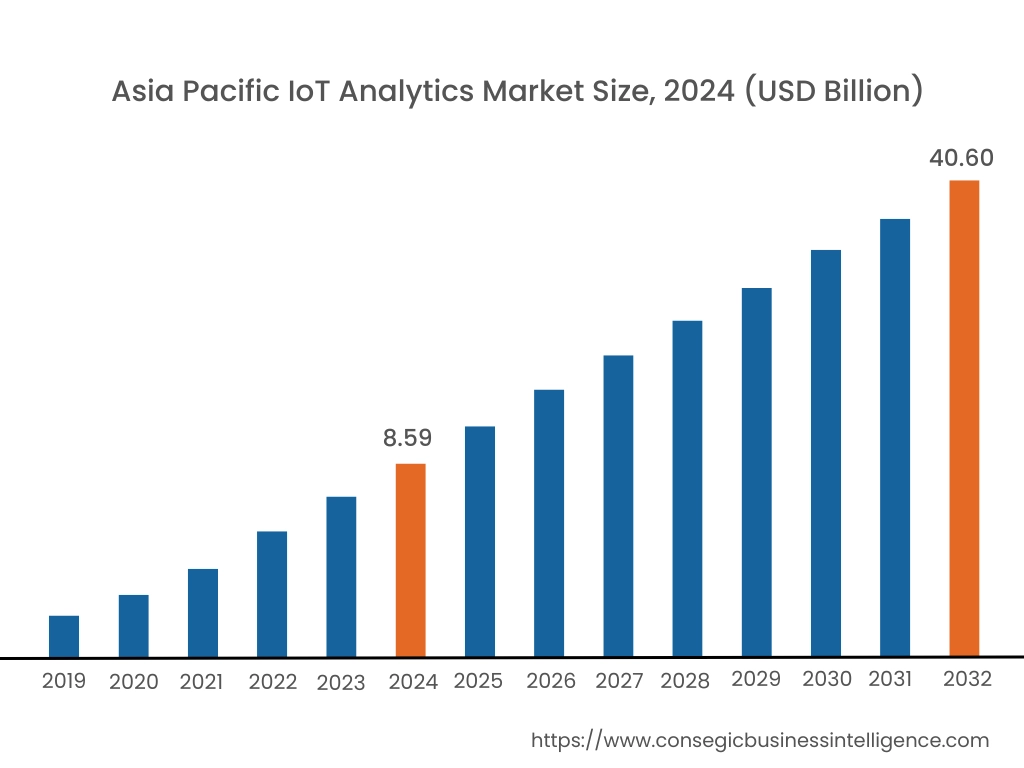
Asia Pacific region was valued at USD 8.59 Billion in 2024. Moreover, it is projected to grow by USD 10.26 Billion in 2025 and reach over USD 40.60 Billion by 2032. Out of this, China accounted for the maximum revenue share of 35.6%. The market expansion in the region is mainly due to the rising adoption of IoT-connected devices across several industries such as healthcare, manufacturing, logistics, and others. Moreover, increasing infrastructure development drives the IoT analytics market expansion.
- For instance, in November 2024, Benjamin & Joseph, a healthcare solution provider, collaborated with SAS Institute Inc. in Singapore to launch a medical bill review solution named ‘Sherlock’. This solution integrates the capabilities of Internet of Things analytics with AI. The above factors are driving the market in the Asia-Pacific region.
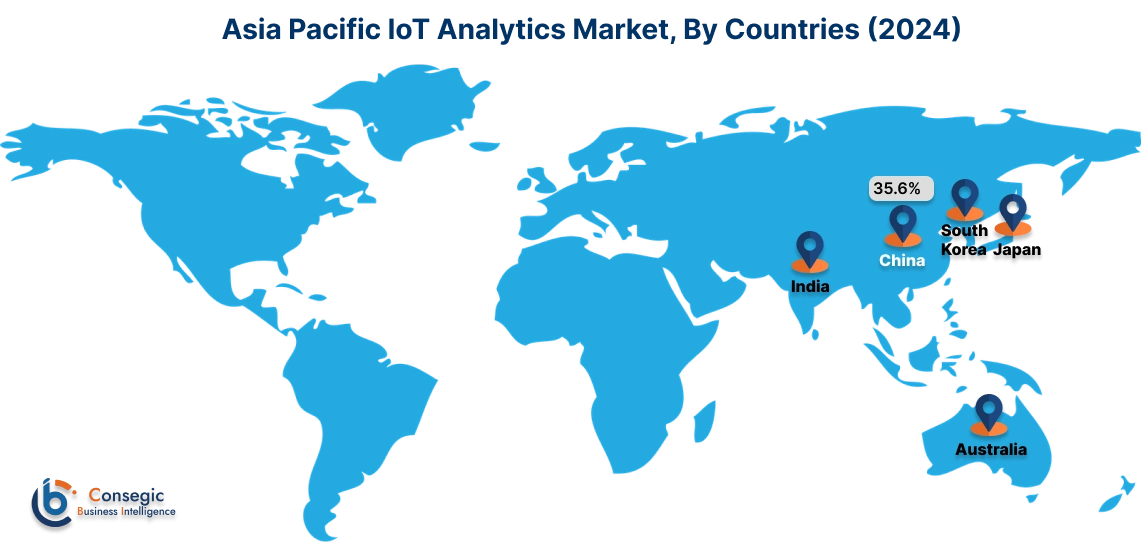
North America is estimated to reach over USD 49.62 Billion by 2032 from a value of USD 10.99 Billion in 2024 and is projected to grow by USD 13.08 Billion in 2025. The market is driven by the rising adoption of IoT devices due to surging Industry 4.0. Moreover, ongoing research and breakthroughs in Internet of Things analytics technologies are propelling the market in North America.
Additionally, in the European region, technological advancements and infrastructure development across industries are driving the market. Moreover, there is a rising potential for the market in the automotive and healthcare sectors due to connected car technologies and digital health solutions. In the Middle East and Africa region, IoT analytics market expansion is led by rising digitalization in the oil and gas sector among others. Furthermore, the market growth in the Latin America region is attributed to smart city and urban development projects, which are driving the deployment of connected IoT devices.
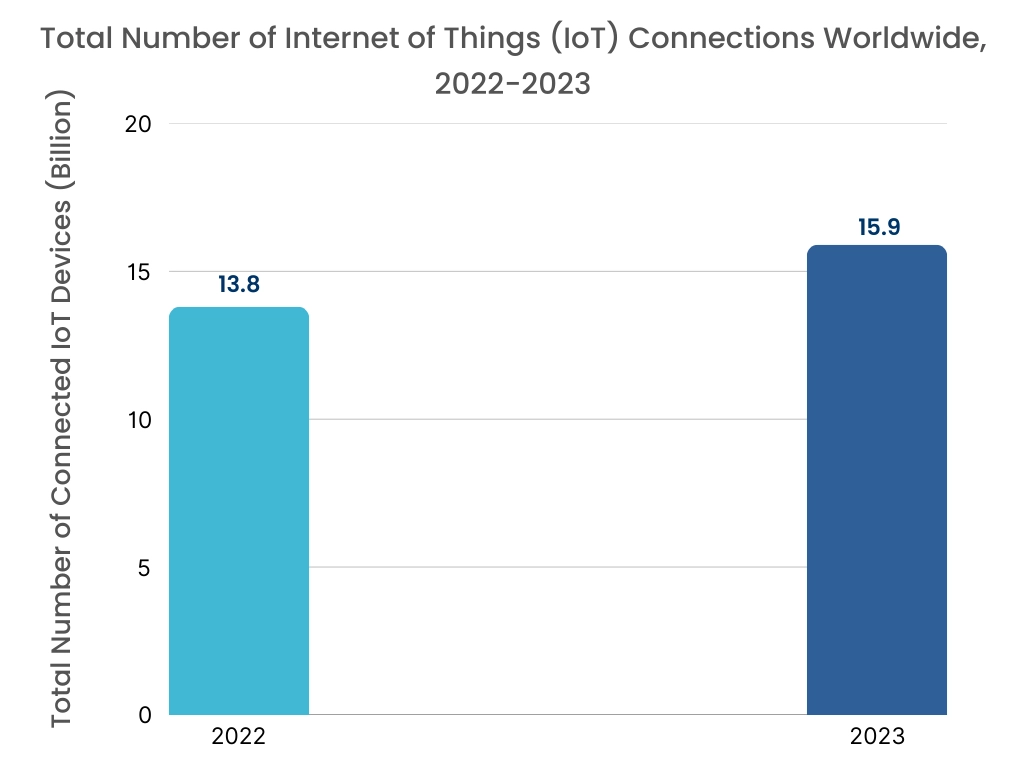
Recent Industry Developments :
Product Launches:
- In November 2024, Telenor IoT launched its analytics and insights service. It offers various features to assist in optimizing operations, reducing risks, and making informed decisions.
- In September 2024, Zoho Corporation launched Zoho IoT, a platform to build and deploy custom IoT solutions. This enables businesses to automate processes and make data-driven decisions efficiently.
Key Questions Answered in the Report
How big is the IoT analytics market? +
IoT Analytics Market size is estimated to reach over USD 149.69 Billion by 2032 from a value of USD 32.67 Billion in 2024 and is projected to grow by USD 38.95 Billion in 2025, growing at a CAGR of 24.1% from 2025 to 2032.
What are the major segments covered in the IoT analytics market report? +
The segments covered in the report include offering, type, deployment mode, application, and end user.
Which region holds the largest revenue share in 2024 in the IoT analytics market? +
North America holds the largest revenue share in the IoT analytics market in 2024.
Who are the major key players in the IoT analytics market? +
The major key players are SAS Institue Inc. (US), and ScienceSoft USA Corporation. (US), ThingSpeak (US), Ina Solutions (US), PTC (US), Yalantis (Poland), Webbylabs (UK), Matellio (UK), Qrvey Inc. (US), Amazon Web Services (US), Tredence (California), HData Systems (India), SumatoSoft (US), Tibbo Systems (Taiwan), Factana Computing Inc. (India), Datadog (US), and Software GmbH (Germany).
